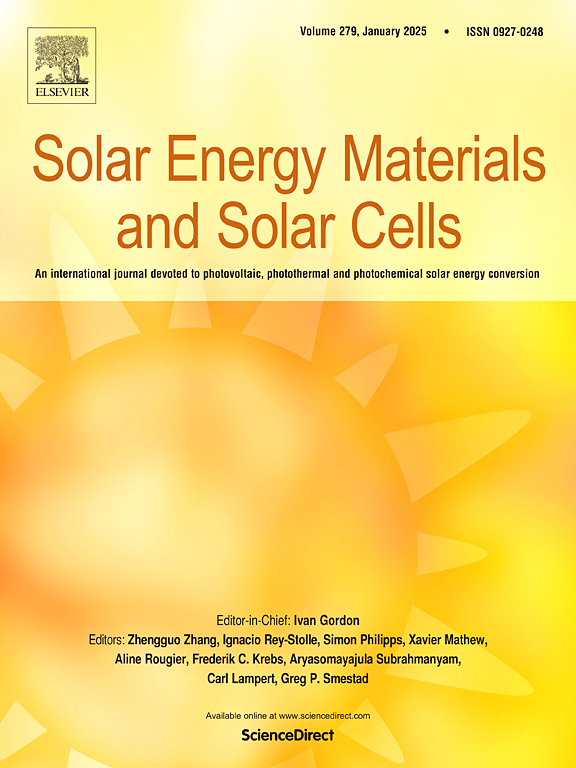Damp-heat stability investigation of glass-backsheet modules based on TOPCon solar cells
IF 6.3
2区 材料科学
Q2 ENERGY & FUELS
引用次数: 0
Abstract
Tunnel oxide passivated contact (TOPCon) solar cells, fabricated using highly reactive silver-aluminium (Ag-Al) paste, are prone to degradation via corrosion when exposed to water vapour and acidic environments. Meanwhile, single-glass (SG) photovoltaic modules conventionally employ polymer-based backsheets that exhibit elevated water vapour transmission rates. This study presents a systematic analysis of the effects of backsheet, metallic paste, encapsulant, and cell spacing on the damp-heat (DH) resilience of SG modules. The investigation ranks the relative impact of these factors on the DH endurance of glass-backsheet modules as follows: backsheet/front metallisation > encapsulant > cell spacing. Notably, modules incorporating an Al composite backsheet with a water permeation rate of 0.01 g/m2/day demonstrated superior DH endurance, whereas modules with a backsheet permitting 0.5 g/m2/day water permeation exhibited a 0.5 % decrease in power loss post-DH1000 ageing relative to conventional polymer backsheets (KPf). A prominent increase in the front finger contact resistance by an order of magnitude was observed post-corrosion. Mitigation strategies include reducing the Al content in metallisation pastes and employing advanced metallisation processes to enhance corrosion resistance. Lower acidic concentrations in the encapsulation film correlate with reduced corrosion. White ethylene-vinyl acetate encapsulants allow for the incorporation of more alkaline additives, decreasing film acid concentration, thereby enhancing DH endurance. With manufacturability and cost effectiveness in consideration, the optimised TOPCon single-glass modules have a post-DH2000 power loss of only 2.37 %, demonstrating a relatively superior level of DH endurance.
TOPCon太阳能电池玻璃背板组件湿热稳定性研究
隧道氧化物钝化接触(TOPCon)太阳能电池是由高活性银铝(Ag-Al)浆料制成的,当暴露在水蒸气和酸性环境中时,容易因腐蚀而降解。与此同时,单玻璃(SG)光伏组件传统上采用聚合物基背板,表现出更高的水蒸气透射率。本研究系统分析了背板、金属膏体、封装剂和电池间距对SG模块湿热(DH)回弹性的影响。该研究将这些因素对玻璃背板模块DH耐久性的相对影响排序如下:背板/正面金属化>;密封剂的在单元格间距。值得注意的是,采用水渗透率为0.01 g/m2/天的Al复合背板的模块表现出更强的耐高温性能,而采用水渗透率为0.5 g/m2/天的背板的模块在dh1000老化后,与传统聚合物背板(KPf)相比,功率损失降低了0.5%。腐蚀后,观察到食指接触电阻显著增加一个数量级。缓解策略包括减少金属化浆料中的Al含量和采用先进的金属化工艺来增强耐腐蚀性。封装膜中酸性浓度的降低与腐蚀程度的降低有关。白色乙烯-醋酸乙烯胶囊允许掺入更多碱性添加剂,降低薄膜酸浓度,从而提高DH耐力。考虑到可制造性和成本效益,优化后的TOPCon单玻璃模块在dh2000后的功率损耗仅为2.37%,显示出相对优越的DH耐力水平。
本文章由计算机程序翻译,如有差异,请以英文原文为准。
求助全文
约1分钟内获得全文
求助全文
来源期刊

Solar Energy Materials and Solar Cells
工程技术-材料科学:综合
CiteScore
12.60
自引率
11.60%
发文量
513
审稿时长
47 days
期刊介绍:
Solar Energy Materials & Solar Cells is intended as a vehicle for the dissemination of research results on materials science and technology related to photovoltaic, photothermal and photoelectrochemical solar energy conversion. Materials science is taken in the broadest possible sense and encompasses physics, chemistry, optics, materials fabrication and analysis for all types of materials.
 求助内容:
求助内容: 应助结果提醒方式:
应助结果提醒方式:


